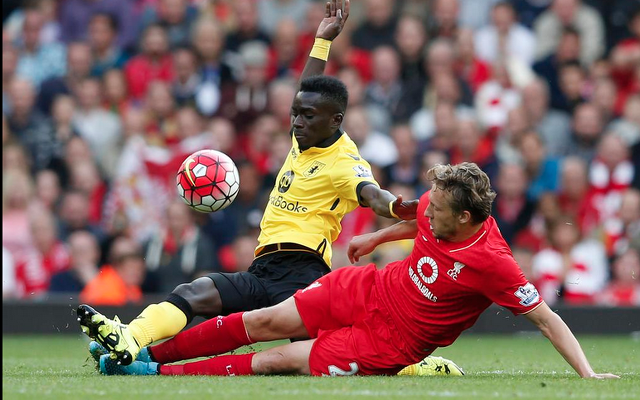Along with perhaps Mamadou Sakho, Lucas has been Liverpool’s best player so far this season.
The Brazilian, our longest serving player having arrived in 2007 from Gremio, almost left to join Besiktas at the start of the campaign, but thankfully didn’t – and has established himself as a vital cog in the centre of the park.
His statistics for breaking up play, tackling and passing are actually as good as any anchorman in Europe right now, and there’s a feeling that he’s finally starting to get the praise he deserves.
And Lucas has excellently explained to FourFourTwo how he’s become expert in his role. The 28-year-old claims his position is about discipline, but mostly about reading and predicting his opponents’ next move.
Under Jurgen Klopp, Lucas is going to be vital in the central midfield. He’s started every Premier League fixture so far and proven a reliable, experienced but classy presence for his new German boss.
Here’s what Lucas had to say:
Read your opponent
“Intercepting a pass may look simple, but it’s not. You need to be able to read your opponent’s moves. The faster you familiarise yourself with their habits, the sooner you’ll be able to have an impact. Knowing your opponent’s game will increase your chances of breaking up the play. You also have to be ready to take advantage of your opponent’s mistakes. If they fail to trap the ball and it escapes their control, make sure you’re on your toes and ready to pounce.”
Foul when you have to
“There are certain situations where you have to commit a deliberate foul – not because you want to injure your opponent or because you’ve mistimed an interception or tackle, but because it’s the only way to stop the other team from scoring. You’ll see a lot of pros commit an intentional foul to stop a quick counter-attack. This stops the play and gives your team-mates time to get back into position. You don’t need to hurt your opponent; just trip them or pull their shirt.”
Expect the worst
“In and out of possession, you need to observe your team-mates’ positions. It’s especially important when your team has the ball because this is when you can be at your most vulnerable. The big detail to look out for when you’re attacking is the movement of your fellow defensive midfielder. If they join the attack, you have to imagine the worst will happen – the opposition get the ball and counter-attack – so make sure you’re in the right place and ready to break up the attack.”
Outsmart brute force
“Big, strong, physical players are the most difficult to compete against in midfield. Yaya Toure is very strong and Marouane Fellaini is formidable in the air. If you’re a smaller player like me, you can’t fight them physically – you won’t win. You’ve got to find another way to battle them. Big players usually aren’t that fast or agile, so expose these weaknesses. On the other hand, you can have as much trouble with a player like Sergio Aguero, who is small but strong and tough to tackle.”
Stop that stronger foot
“Watch your opponent’s dominant foot. Most of a player’s moves will come from their favoured foot. If you’re up against a playmaker who prefers one foot, stop them using it – this will prevent them creating chances and shooting. It’s not a perfect science; you also have to look at their eyes and body shape and anticipate whether they’re going for a one-two or a dribble. Try to imagine what they’re going to do next.”
Keep your passing snappy
“If I could summarise my role, I’d say it is to read the game and distribute the ball quickly with short, simple passes – holding midfielders should not go for the most difficult option. Passing the ball forward is the key to maintaining tempo. I have to make sure I am in the right place at the right time to receive the ball. I read my team-mates’ movements. Short, sharp passing in training with other players pressurising you forces you to think faster – that’s how you develop.”
